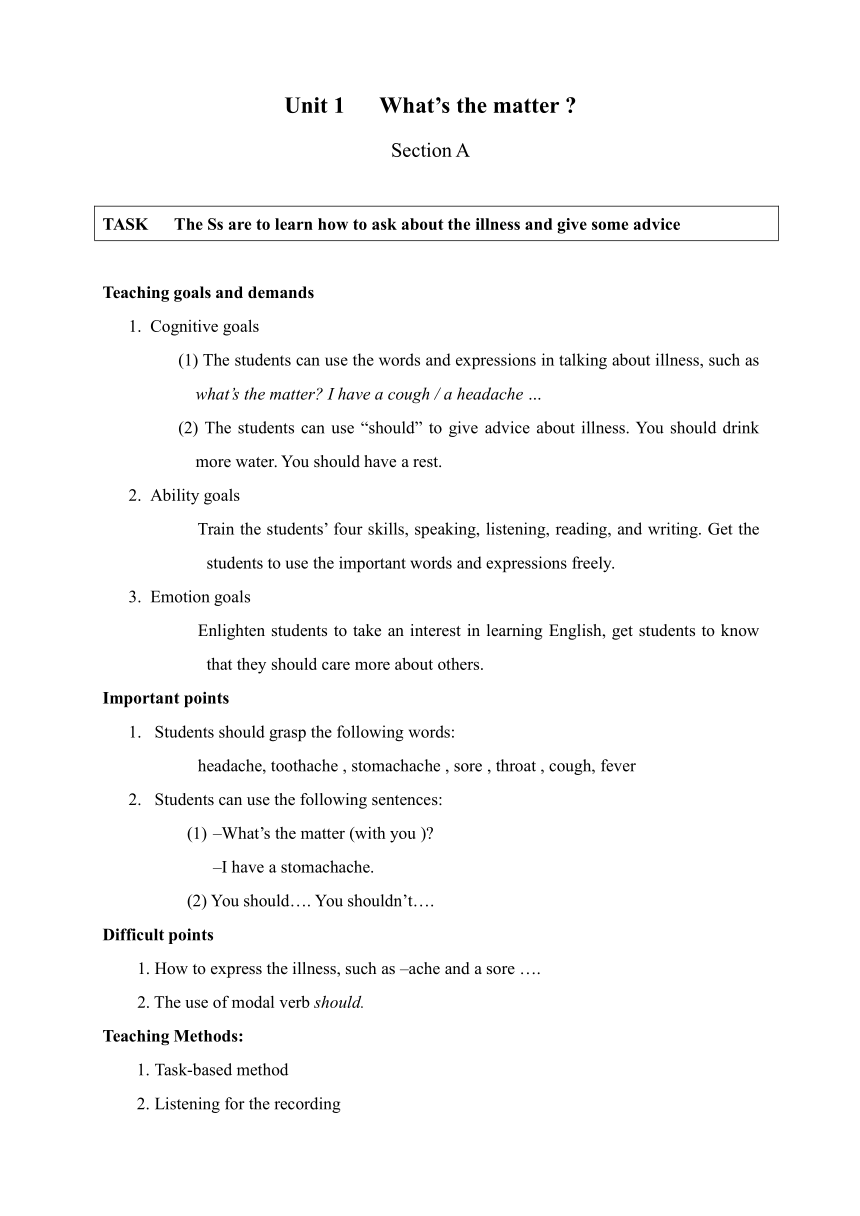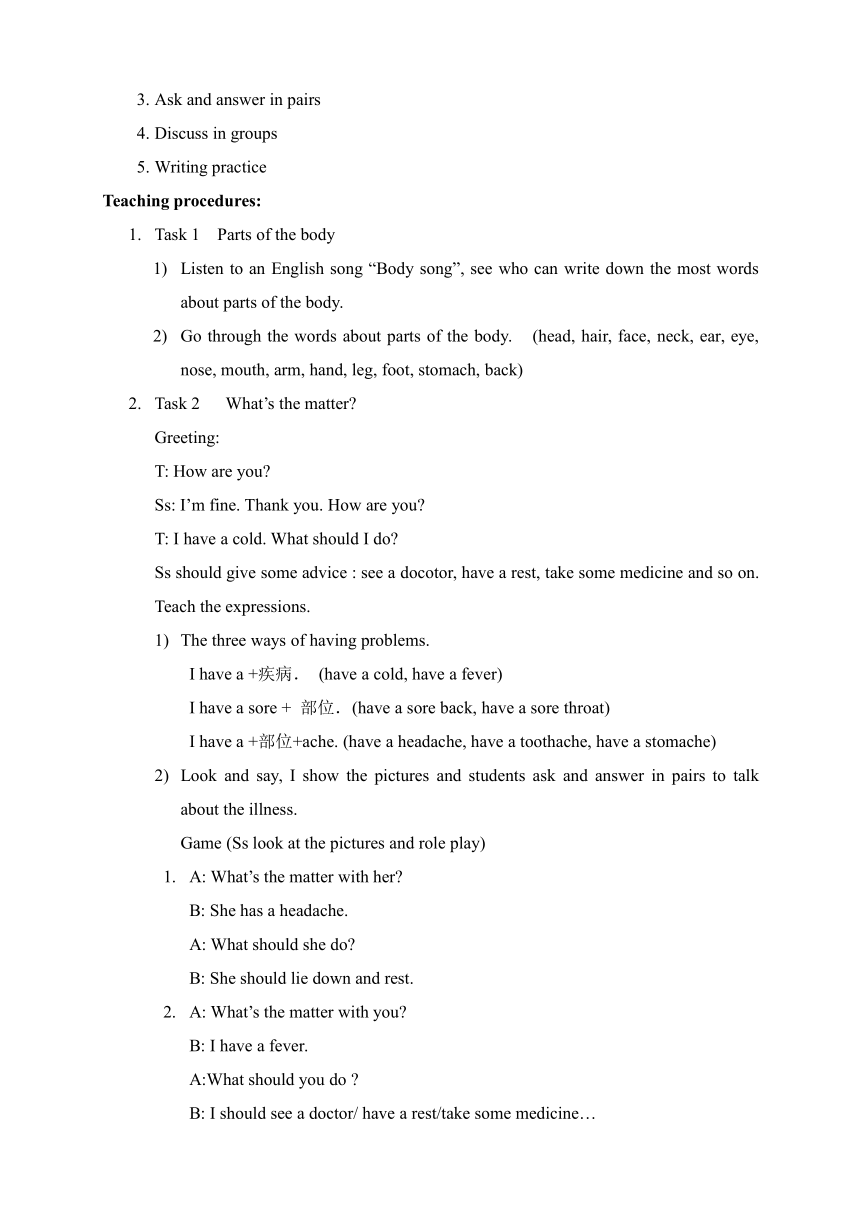人教版八年级下册 Unit1 What's the matter? SectionA 1a-2d 教案
文档属性
| 名称 | 人教版八年级下册 Unit1 What's the matter? SectionA 1a-2d 教案 |  | |
| 格式 | doc | ||
| 文件大小 | 54.5KB | ||
| 资源类型 | 教案 | ||
| 版本资源 | 人教新目标(Go for it)版 | ||
| 科目 | 英语 | ||
| 更新时间 | 2022-12-18 23:37:53 | ||
图片预览


文档简介
Unit 1 What’s the matter
Section A
TASK The Ss are to learn how to ask about the illness and give some advice
Teaching goals and demands
1. Cognitive goals
(1) The students can use the words and expressions in talking about illness, such as what’s the matter I have a cough / a headache …
(2) The students can use “should” to give advice about illness. You should drink more water. You should have a rest.
2. Ability goals
Train the students’ four skills, speaking, listening, reading, and writing. Get the students to use the important words and expressions freely.
3. Emotion goals
Enlighten students to take an interest in learning English, get students to know that they should care more about others.
Important points
1. Students should grasp the following words:
headache, toothache , stomachache , sore , throat , cough, fever
2. Students can use the following sentences:
(1) –What’s the matter (with you )
–I have a stomachache.
(2) You should…. You shouldn’t….
Difficult points
1. How to express the illness, such as –ache and a sore ….
2. The use of modal verb should.
Teaching Methods:
1. Task-based method
2. Listening for the recording
3. Ask and answer in pairs
4. Discuss in groups
5. Writing practice
Teaching procedures:
1. Task 1 Parts of the body
1) Listen to an English song “Body song”, see who can write down the most words about parts of the body.
2) Go through the words about parts of the body. (head, hair, face, neck, ear, eye, nose, mouth, arm, hand, leg, foot, stomach, back)
2. Task 2 What’s the matter
Greeting:
T: How are you
Ss: I’m fine. Thank you. How are you
T: I have a cold. What should I do
Ss should give some advice : see a docotor, have a rest, take some medicine and so on. Teach the expressions.
1) The three ways of having problems.
I have a +疾病. (have a cold, have a fever)
I have a sore + 部位.(have a sore back, have a sore throat)
I have a +部位+ache. (have a headache, have a toothache, have a stomache)
2) Look and say, I show the pictures and students ask and answer in pairs to talk about the illness.
Game (Ss look at the pictures and role play)
1. A: What’s the matter with her
B: She has a headache.
A: What should she do
B: She should lie down and rest.
2. A: What’s the matter with you
B: I have a fever.
A:What should you do
B: I should see a doctor/ have a rest/take some medicine…
3) How to ask about illness.
What’s wrong (with you)
What’s the matter (with you)
What’s your trouble
What happens to you
Is there anything wrong with you
3. Task 3 Give advice
1) Listen to the tape in 2a and match the problem with the advice. Then listen again and fill in the blanks in 2b. After several minutes, correct the answers.
2) Work in pairs and practice the conversation in activity 2b. Take turns having a problem and giving advice. Then have several pairs of students present their conversations to the class.
3) Look at the picture on PPT and ask students to describe it. Call attention to the dialogue and point out the blanks in the dialogue. First let students think of it and check the answers.
4. Groupwork.
Divide the class into some groups, let them work in groups, fill in the chart, and ask a student to make a report of the illness and advice.
Name Illness Advice
Wang Ming toothache see a dentist
Wang Ming is a smart girl. She has a toothache. She should see a dentist.
Li Lei is a tall boy. He has a sore throat. He should drink some hot tea with honey.
Li Lan is a pretty girl. She has a fever. She should take her temperature, drink lots of hot water and have a good rest.
5. Survey
Make a survey about the students’ health. Discuss in groups. Give advice about how to keep healthy. Complete the chart, then make a report of the result.
How to keep healthy
We should have a healthy lifestyle.
We should eat fruit and vegetables everyday
We should go to bed early.
We should often exercise.
We should eat a balanced diet.
We shouldn’t eat too much junk food.
We shouldn’t watch too much TV.
We shouldn’t sleep too late.
We shouldn’t ……
PAGE
Section A
TASK The Ss are to learn how to ask about the illness and give some advice
Teaching goals and demands
1. Cognitive goals
(1) The students can use the words and expressions in talking about illness, such as what’s the matter I have a cough / a headache …
(2) The students can use “should” to give advice about illness. You should drink more water. You should have a rest.
2. Ability goals
Train the students’ four skills, speaking, listening, reading, and writing. Get the students to use the important words and expressions freely.
3. Emotion goals
Enlighten students to take an interest in learning English, get students to know that they should care more about others.
Important points
1. Students should grasp the following words:
headache, toothache , stomachache , sore , throat , cough, fever
2. Students can use the following sentences:
(1) –What’s the matter (with you )
–I have a stomachache.
(2) You should…. You shouldn’t….
Difficult points
1. How to express the illness, such as –ache and a sore ….
2. The use of modal verb should.
Teaching Methods:
1. Task-based method
2. Listening for the recording
3. Ask and answer in pairs
4. Discuss in groups
5. Writing practice
Teaching procedures:
1. Task 1 Parts of the body
1) Listen to an English song “Body song”, see who can write down the most words about parts of the body.
2) Go through the words about parts of the body. (head, hair, face, neck, ear, eye, nose, mouth, arm, hand, leg, foot, stomach, back)
2. Task 2 What’s the matter
Greeting:
T: How are you
Ss: I’m fine. Thank you. How are you
T: I have a cold. What should I do
Ss should give some advice : see a docotor, have a rest, take some medicine and so on. Teach the expressions.
1) The three ways of having problems.
I have a +疾病. (have a cold, have a fever)
I have a sore + 部位.(have a sore back, have a sore throat)
I have a +部位+ache. (have a headache, have a toothache, have a stomache)
2) Look and say, I show the pictures and students ask and answer in pairs to talk about the illness.
Game (Ss look at the pictures and role play)
1. A: What’s the matter with her
B: She has a headache.
A: What should she do
B: She should lie down and rest.
2. A: What’s the matter with you
B: I have a fever.
A:What should you do
B: I should see a doctor/ have a rest/take some medicine…
3) How to ask about illness.
What’s wrong (with you)
What’s the matter (with you)
What’s your trouble
What happens to you
Is there anything wrong with you
3. Task 3 Give advice
1) Listen to the tape in 2a and match the problem with the advice. Then listen again and fill in the blanks in 2b. After several minutes, correct the answers.
2) Work in pairs and practice the conversation in activity 2b. Take turns having a problem and giving advice. Then have several pairs of students present their conversations to the class.
3) Look at the picture on PPT and ask students to describe it. Call attention to the dialogue and point out the blanks in the dialogue. First let students think of it and check the answers.
4. Groupwork.
Divide the class into some groups, let them work in groups, fill in the chart, and ask a student to make a report of the illness and advice.
Name Illness Advice
Wang Ming toothache see a dentist
Wang Ming is a smart girl. She has a toothache. She should see a dentist.
Li Lei is a tall boy. He has a sore throat. He should drink some hot tea with honey.
Li Lan is a pretty girl. She has a fever. She should take her temperature, drink lots of hot water and have a good rest.
5. Survey
Make a survey about the students’ health. Discuss in groups. Give advice about how to keep healthy. Complete the chart, then make a report of the result.
How to keep healthy
We should have a healthy lifestyle.
We should eat fruit and vegetables everyday
We should go to bed early.
We should often exercise.
We should eat a balanced diet.
We shouldn’t eat too much junk food.
We shouldn’t watch too much TV.
We shouldn’t sleep too late.
We shouldn’t ……
PAGE
同课章节目录
- Unit 1 What's the matter?
- Section A
- Section B
- Unit 2 I'll help to clean up the city parks.
- Section A
- Section B
- Unit 3 Could you please clean your room?
- Section A
- Section B
- Unit 4 Why don't you talk to your parents?
- Section A
- Section B
- Unit 5 What were you doing when the rainstorm came
- Section A
- Section B
- Review of Units 1-5
- Unit 6 An old man tried to move the mountains.
- Section A
- Section B
- Unit 7 What's the highest mountain in the world?
- Section A
- Section B
- Unit 8 Have you read Treasure Island yet?
- Section A
- Section B
- Unit 9 Have you ever been to a museum?
- Section A
- Section B
- Unit 10 I've had this bike for three years.
- Section A
- Section B
